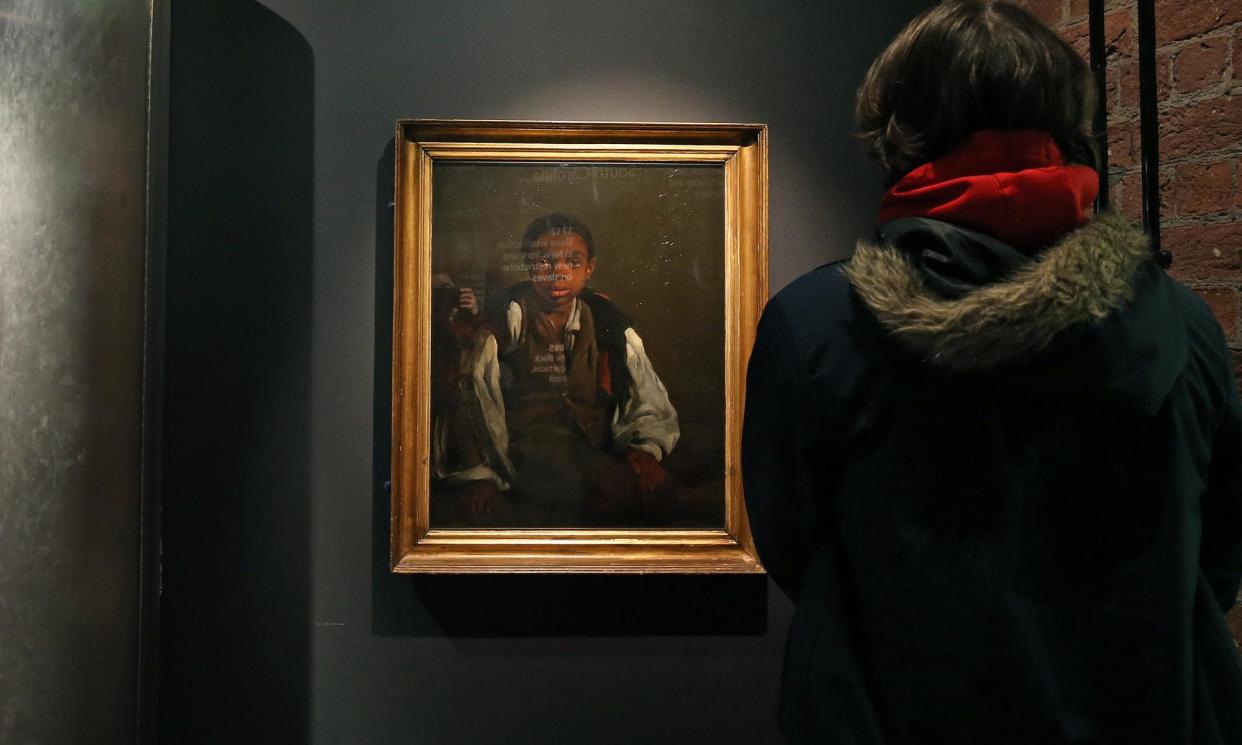Liverpool museum appeals for information on subject of The Black Boy

The subject of the painting gazes at the viewer, alone and barefoot in loose and torn clothing. Known only as The Black Boy, his identity has been a mystery for nearly 200 years.
A museum is appealing for information about the mysterious sitter, who is rumoured to have stowed away on a ship to Liverpool – possibly to escape slavery in America – after research about the artist, William Lindsay Windus, and X-rays of the painting revealed potential clues to the boy’s identity.
It is the only painted portrait of an individual Black child on display at the International Slavery Museum in Liverpool and the only oil painting of such a subject that exists within the entire collection of National Museums Liverpool.
Kate Haselden, who researched the 180-year-old portrait for the museum, said that historical paintings representing Black subjects as servants or enslaved people are far more common.
“Single figure Black sitter portraits are very rare,” she said, adding that portraits of Black children are even rarer. “I’ve counted less than 10 for that period in the UK national collections. It’s especially rare to have a finished, sensitive, well-executed painting.”
X-rays have revealed that Windus, a pre-Raphaelite artist who was only 22 when he painted The Black Boy in 1844, painted “four or five” other faces on the canvas before making the unconventional decision to settle on an individual Black child as his final subject.
“He kept working until he created this image,” said Haselden. “This is the one he wanted to keep.”
She said that Windus also paid an unusual amount of attention to the child’s dark skin tone, giving it depth. “When you look closely, you see there are pinks and reds, and that is very rare,” she added.
By portraying the child gazing directly at the viewer, Windus is trying to invoke empathy for his pitiful subject, but in a dignified and slightly confrontational way, she said. “He’s making direct eye contact, he’s holding your attention and he’s making you look directly at him.”
At the same time, Windus uses the light shining in from the right-hand side of the portrait to illuminate the child’s face and convey his innocence and purity, she said. “It’s very ahead of its time – and it’s really showing off Windus’s skills as a painter.”
In 1891, nearly 50 years after the painting was created, a listing in a catalogue claimed the boy was a stowaway whom Windus had met on the steps of the Monument hotel in Liverpool. According to this narrative, Windus took pity on the boy’s condition, employed him as an errand boy and sent his portrait off to a frame-maker’s shop. Serendipitously, a passing sailor spotted it, realised the child was his missing relative – and reunited the boy with his parents.
This charitable tale, with its unlikely happy ending, would have made the portrait more appealing to wealthy Victorian art buyers.
“It’s a wonderful story, but I’m quite sceptical,” said Haselden. “This child may have been a native Liverpudlian. Black people have been living in Liverpool since at least the 1730s.”
The museum has discovered that Windus’s mother ran the Monument hotel in the city – now a hairdressers on London Road – and Windus was living there when he painted The Black Boy for a local acquaintance.
“London Road was home to a lot of lodging houses and pubs and it was a stagecoach route,” Haselden said. She thinks Windus crossed paths with people from different walks of life coming into the city for work and travelling out of Liverpool, including the Black sitter. “I think he’s painted a scene from his own life and what he encountered.”
Prior to this discovery, experts thought Windus was a typical middle-class artist who was depicting picturesque poverty in order to remind Victorian art buyers about their high status and good fortune.
The museum has put up an appeal online for information about the sitter, asking people to use a Google form to share their clues.
“When we think about Black presence in art, there is so much anonymity there,” said Haselden. “There are so many figures that are unnamed.”
As a curator of mixed-race heritage in Liverpool, she said she wanted to “do justice” to the sitter and call The Black Boy by his name. She added: “His story is central to the development and history of our city, and he deserves to be more widely acknowledged.”
Any documents relating to the Liverpool Academy of Arts in the 1840s, which Windus was a member of, and any letters Windus wrote, would be of particular interest.
“It could be anything: documents, a sketch or a letter. Or perhaps you are a descendant of the artist, or the boy himself.”


